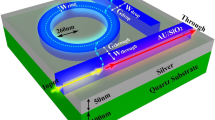Abstract
Liquid crystal (LC) has proven to be a promising material for microwave (µWave) phase shifters at GHz ranges, due to their continuous and wide tunability, as well as reasonably low absorption loss. However, designing LC phase shifters that meet specific application requirements (e.g., SpaceTech) is a challenging task that entails a complex trade-off between various parameters. Physics-informed machine learning (PI-ML) combines the power of machine learning with the underlying physics to develop a more accurate and interpretable model. Leveraging PI-ML to inform LC µWave device design is a relatively new area, with tremendous opportunities for exploration and innovation. In this article, a deep learning assisted LC µWave phase shifter design and synthesis framework is proposed. By incorporating physical constraints and knowledge into deep neural networks, one can effectively balance the trade-off between different design parameters and synthesize LC phase shifter structures that meet specific performance requirements (e.g., insertion loss, insertion loss balancing, phase tuning range, tuning speed, power consumption). The framework is envisaged to allow for the efficient and effective exploration of the design space, resulting in improved accuracy and efficiency compared to traditional two-stage design methods.
Access this chapter
Tax calculation will be finalised at checkout
Purchases are for personal use only
Similar content being viewed by others
References
Somjit, N., Robertson, I., Chongcheawchamnan, M.: Electronic design automation. In: Microwave and millimetre-wave design for wireless communications, 1st edn. Wiley, New Jersey (2016)
Marek, A., et al.: Benefits of advanced full-wave vector analysis codes for the design of high-power microwave tubes. In: 2018 11th German Microwave Conference (GeMiC), pp. 279–282, Freiburg, Germany (2018)
Hammadi, S., Grondin, R.O., El-Ghazaly, S., et al.: Full-wave electromagnetic simulation of millimeter-wave active devices and circuits. Ann. Télécommun. 54, 30–42 (1999)
Benson, T.M., Ata, O.W., Soghomonian, M., Marincic, A.S.: Application of finite difference and optical ray tracing methods to the design of microwave components. In: IEE Colloquium on Computer Based Tools for Microwave Engineers, pp. 9/1–9/6, London, UK (1991)
Naishadham, K., Misra, P.: Order recursive method of moments: a powerful computational tool for microwave CAD and optimization. In: 1996 IEEE MTT-S International Microwave Symposium Digest. San Francisco, pp. 1463–1466. CA, USA (1996)
Jinfeng, L.: Performance limits of 433 MHz quarter-wave monopole antennas due to grounding dimension and conductivity. Ann. Emerg. Technol. Comput. 6(3), 1–10 (2022)
Lukic, M., Kim, K., Lee, Y., Saito, Y., Filipovic, D.S.: Multi-physics design and performance of a surface-micromachined Ka-band cavity backed patch antenna. In: 007 SBMO/IEEE MTT-S International Microwave and Optoelectronics Conference, pp. 321–324. Salvador, Brazil (2007)
Steer, M.B., Bandler, J.W., Snowden, C.M.: Computer-aided design of RF and microwave circuits and systems. IEEE Trans. Microwave Theory Tech. 50(3), 996–1005 (2002)
May, M.P., Taflove, A., Baron, J.: FD-TD modeling of digital signal propagation in 3-D circuits with passive and active loads. IEEE Trans. Microwave Theory Tech. 42, 1514–1523 (1994)
Jinfeng, L.: Optically steerable phased array enabling technology based on mesogenic azobenzene liquid crystals for starlink towards 6G. In: 2020 IEEE Asia-Pacific Microwave Conference (APMC), pp. 345–347. IEEE, Hong Kong (2020)
Papanicolaou, N.C., Christou, M.A., Polycarpou, A.C., Nestoros, M., Tchema, R.: Electromagnetic modeling and simulation of microwave and mm-wave devices based on liquid crystal compounds. AIP Conf. Proc. 2302, 110006 (2020)
Chodorow, U., Parka, J., Chojnowska, O.: Liquid crystal materials in THz technologies. Photon. Lett. PL 4(3), 112–114 (2012)
Michael, P.A.: Molecular simulation of liquid crystals. Mol. Phys. 117(18), 2391–2417 (2019)
Jinfeng, L.: Wideband PCB-to-connectors impedance adapters for liquid crystal-based low-loss phase shifters. In: 2020 50th European Microwave Conference (EuMC), pp. 546–549. IEEE, Utrecht, Netherlands (2021)
Jinfeng, L.: An efficient mixed-signal dielectric-partitioning model of liquid crystals based shielded coplanar waveguide for electronically reconfigurable delay lines design. In: Proceeding SPIE, Integrated Optics: Design, Devices, Systems and Applications VI 11775, 1177519 (2021)
Jinfeng, L.: Rethinking liquid crystal tunable phase shifter design with inverted microstrip lines at 1–67 GHz by dissipative loss analysis. Electronics 12(2), 421 (2023)
Jinfeng, L., Daping, C.: Liquid crystal-based enclosed coplanar waveguide phase shifter for 54–66 GHz applications. Crystals 9(12), 650 (2019)
Jinfeng, L.: Rethinking figure-of-merits of liquid crystals shielded coplanar waveguide phase shifters at 60 GHz. J—Multi. Sci. J. 4(3), 444–451 (2021)
Jinfeng, L.: Machine learning and digital twinning enabled liquid crystals mm-wave reconfigurable devices design and systems operation. In: 2022 IEEE MTT-S International Microwave Workshop Series on Advanced Materials and Processes for RF and THz Applications, pp. 1–3. IEEE, Guangzhou, China (2022)
Karniadakis, G.E., Kevrekidis, I.G., Lu, L., et al.: Physics-informed machine learning. Nat. Rev. Phys. 3, 422–440 (2021)
Mahdi, H.M., Maaruf, A.: Integration of blockchain and IoT: an enhanced security perspective. Ann. Emerg. Technol. Comput. 4(4), 52–63 (2020)
Jinfeng, L.: Towards 76–81 GHz scalable phase shifting by folded dual-strip shielded coplanar waveguide with liquid crystals. Ann. Emerg. Technol. Comput. 5(4), 14–22 (2021)
Jinfeng, L.: Challenges and opportunities for nematic liquid crystals in radio frequency and beyond. Crystals 2(5), 632 (2022)
Ashraf, A., Andrew, W.: Effective performance metrics for multimedia mission-critical communication systems. Ann. Emerg. Technol. Comput. 5(2), 1–14 (2021)
Jinfeng, L.: From liquid crystal on silicon and liquid crystal reflectarray to reconfigurable intelligent surfaces for post-5G networks. Appl. Sci. 13(13), 7407 (2023)
Acknowledgement
The support from the Research Fund Programme for Young Scholars at BIT and the National Natural Science Foundation of China (Grant 62301043) is acknowledged.
Author information
Authors and Affiliations
Corresponding author
Editor information
Editors and Affiliations
Rights and permissions
Copyright information
© 2024 ICST Institute for Computer Sciences, Social Informatics and Telecommunications Engineering
About this paper
Cite this paper
Li, J. (2024). Physics-Informed Machine Learning Assisted Liquid Crystals µWave Phase Shifters Design and Synthesis. In: Miraz, M.H., Southall, G., Ali, M., Ware, A. (eds) Emerging Technologies in Computing. iCETiC 2023. Lecture Notes of the Institute for Computer Sciences, Social Informatics and Telecommunications Engineering, vol 538. Springer, Cham. https://doi.org/10.1007/978-3-031-50215-6_1
Download citation
DOI: https://doi.org/10.1007/978-3-031-50215-6_1
Published:
Publisher Name: Springer, Cham
Print ISBN: 978-3-031-50214-9
Online ISBN: 978-3-031-50215-6
eBook Packages: Computer ScienceComputer Science (R0)




